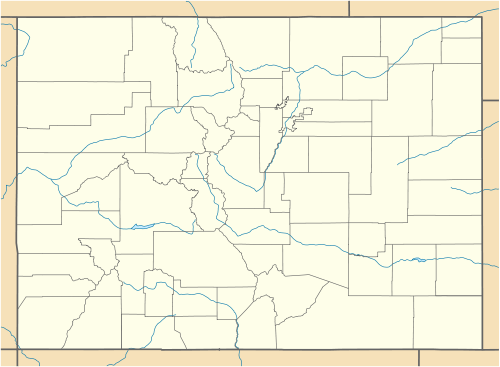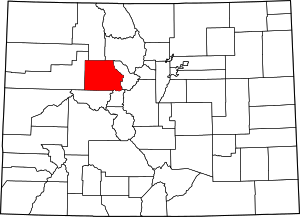Dotsero, Colorado
| Dotsero, Colorado | |
|---|---|
| Census-designated place | |
|
Houses in Dotsero along the south side of Interstate 70, along the Eagle River | |
 Dotsero Location within the state of Colorado | |
| Coordinates: 39°39′0″N 107°3′30″W / 39.65000°N 107.05833°WCoordinates: 39°39′0″N 107°3′30″W / 39.65000°N 107.05833°W | |
| Country | United States |
| State | Colorado |
| County | Eagle |
| Area | |
| • Total | 1.6 sq mi (4.1 km2) |
| • Land | 1.4 sq mi (3.6 km2) |
| • Water | 0.2 sq mi (0.5 km2) |
| Elevation | 6,150 ft (1,870 m) |
| Population (2010) | |
| • Total | 705 |
| • Density | 501/sq mi (193.6/km2) |
| Time zone | Mountain (MST) (UTC-7) |
| • Summer (DST) | MDT (UTC-6) |
| ZIP code | 81637 |
| FIPS code | 08-21155 |
| GNIS feature ID | 174006 |
Dotsero is an unincorporated community and census-designated place (CDP) in western Eagle County, Colorado, in the United States. The population as of the 2010 Census was 705.[1] The town originated as a railroad junction and is located at the confluence of the Eagle River with the Colorado River, along U.S. Highway 6 and Interstate 70, near the head of Glenwood Canyon, approximately 5 miles (8 km) west of Gypsum. The town consists mostly of a cluster of houses and trailers on both sides of the Eagle River.
Railroad
Dotsero was an important railroad junction point for the Denver and Rio Grande Western Railroad's Denver to Salt Lake City line. Originally the line passed through Dotsero following the Eagle River towards Tennessee Pass and through the Royal Gorge of the Arkansas River in route to Pueblo, Colorado before turning north towards Denver. Through the years, efforts were made to have a more direct connection between Denver and Salt Lake that did not require detouring through Pueblo. The Denver and Salt Lake Railroad (D&SL) built a line west from Denver and entered the Colorado River canyon near Bond, Colorado, about 40 miles (64 km) Northeast of Dotsero. The D&SL was never finished as a separate route to Salt Lake City; however, was eventually acquired by the D&RGW, who built a connection between Dotsero and Orestod (Dotsero spelled backwards) near Bond. This connection, commonly known as the Dotsero Cutoff, was completed on June 15, 1934 and finally provided Denver with a direct link to Salt Lake City, making Dotsero the junction between the old and new routes to Denver.[2] After completion the old route over Tennessee pass remained in use as a secondary route, but has been dormant since 1997.[3]
Ferdinand Hayden published an extensive survey of central and southwest Colorado in 1877,[4] and used the location of the town of Dotsero as his "Dot Zero" (reference point) for his survey maps. The station name exists from the construction of the standard gauge railroad line to Glenwood Springs in the 1890s.
Volcano
Dotsero is built at the base of Colorado's most recently active volcano, the Dotsero Crater, which, according to the United States Geological Survey, erupted 4,140 years ago.[5]
The main industry at Dotsero for years consisted of making cinderblocks from the volcano.
See also
| Wikimedia Commons has media related to Dotsero, Colorado. |
References
- ↑ Colorado Trend Report 2: State and Complete Places (Sub-state 2010 Census Data). Missouri Census Data Center. Accessed 2011-02-25.
- ↑ "Building the Dotsero Cutoff". ND Holmes. December 16, 2015. Retrieved March 18, 2016.
- ↑ "D&RG/D&RGW Tennessee Pass Route History". ND Holmes. July 28, 2011. Retrieved March 18, 2016.
- ↑ Atlas of Colorado
- ↑ America's Volcanic Past, USGS


